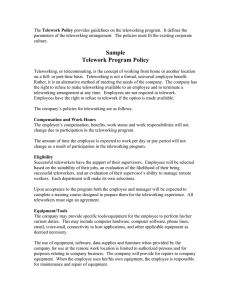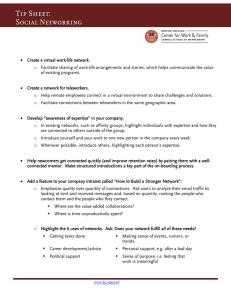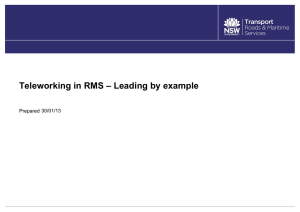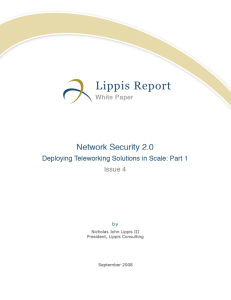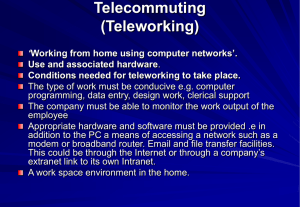Employees who work from home
advertisement
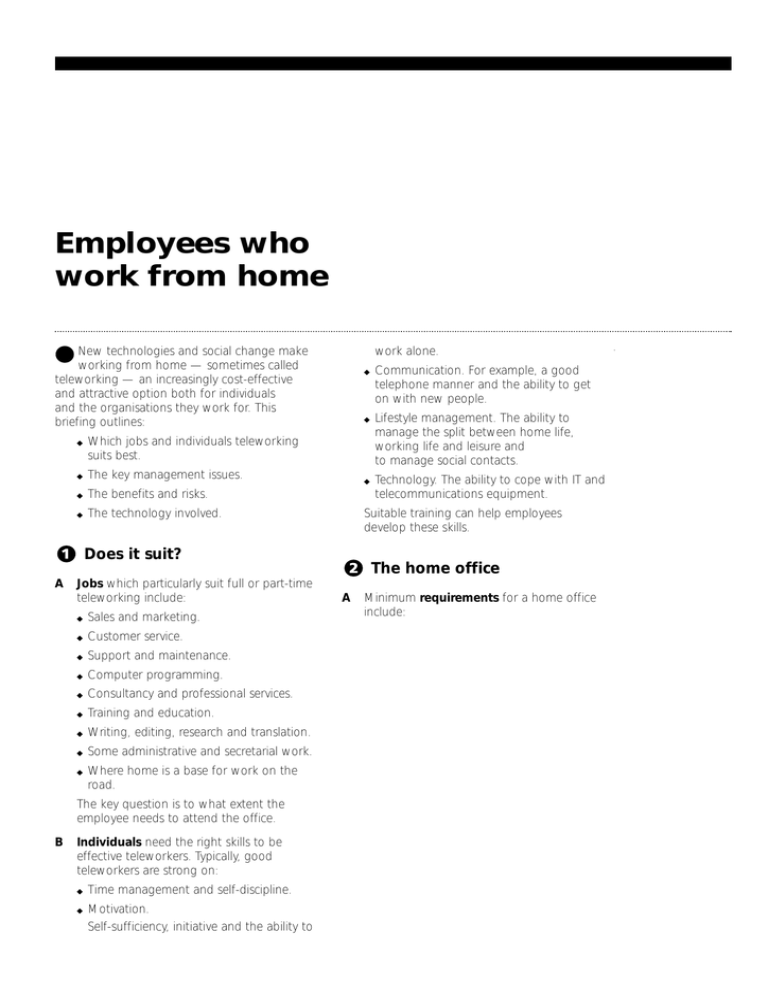
Employees who work from home New technologies and social change make working from home — sometimes called teleworking — an increasingly cost-effective and attractive option both for individuals and the organisations they work for. This briefing outlines: ◆ Which jobs and individuals teleworking suits best. ◆ The key management issues. ◆ The benefits and risks. ◆ The technology involved. Does it suit? A Jobs which particularly suit full or part-time teleworking include: ◆ Sales and marketing. ◆ Customer service. ◆ Support and maintenance. ◆ Computer programming. ◆ Consultancy and professional services. ◆ Training and education. ◆ Writing, editing, research and translation. ◆ Some administrative and secretarial work. ◆ Where home is a base for work on the road. The key question is to what extent the employee needs to attend the office. B Individuals need the right skills to be effective teleworkers. Typically, good teleworkers are strong on: ◆ Time management and self-discipline. ◆ Motivation. Self-sufficiency, initiative and the ability to work alone. ◆ Communication. For example, a good telephone manner and the ability to get on with new people. ◆ Lifestyle management. The ability to manage the split between home life, working life and leisure and to manage social contacts. ◆ Technology. The ability to cope with IT and telecommunications equipment. Suitable training can help employees develop these skills. The home office A Minimum requirements for a home office include: ◆ A work space and reasonable working environment. Small flats and noisy locations are less suitable. ◆ Secure premises and a lockable cupboard or desk. Shared accommodation can present security and confidentiality problems. ◆ Compliance with health and safety regulations (see B), including suitable furniture. ◆ One or more business telephone lines and, possibly, broadband. ◆ An Internet-capable computer with office software, including email and a printer (see 7). ◆ Fax machine or fax modem. ◆ Adequate insurance. Home contents insurance normally excludes business equipment, which the company must pay for. Additional insurance may be required if you have visitors or business meetings at home. Vetting homes can embarrass employees and risks sexual harassment issues. Instead, issue employees with guidance so they can assess whether their premises are suitable. B An initial risk assessment must be carried out although this can be done by the employee. Areas to consider are: Flexible working options Flexible working is a catch-all phrase that covers any working pattern other than the normal working pattern. ◆ ◆ B At home. Employees without suitable home premises may use a local business centre as a home office. On the road. Sales and support staff, or employees with long journeys to work, may be able to work while travelling. At customer’s premises. Employees working at a customer’s premises for a major contract need to be managed in the same way as teleworkers. Employees may work on a different basis. ◆ This may involve changes to the hours and times worked eg flexitime, compressed hours, annual hours or staggered hours. ◆ Employees might have a job-sharing arrangement. ◆ Shift work, part-time work and termtime work also count as flexible work. By law you must ‘consider seriously’ requests to work flexibly made by an employee who is a parent with a child under six or a disabled child under 18. See The law on flexible working, HR 38. ◆ The seating and layout of the employee’s computer workstation. ◆ Electrical equipment. Has it been tested and certified? ◆ Extension leads for telephones, PCs and printers. Make sure there are no trailing leads. ◆ Adequate lighting levels, ventilation and room temperature. You will need to give employees simple, specific health and safety advice and record what has been done. See Health and safety, LA 3. A Employees may work in different locations. ◆ Health and safety requirements are not reduced by working at home and apply just as they do to those who work in the office. . C Planning permission is unlikely to be required if all the following are true: ◆ Only one room is used for teleworking. ◆ Only those who live in the house work there. ◆ The work does not lead to a substantial volume of visitors, nuisance to neighbours or extra car parking. D Tax and business rates are not usually a problem. Ensure that the room used has another purpose (eg visitors’ bedroom) to avoid paying: ◆ Business rates. ◆ Capital gains tax on sale of the property. Benefits and risks A The main benefit of working from home is increased productivity, through: ◆ More efficient use of time. For example, fewer interruptions and less commuting time. ◆ Improved employee retention. For example, helping parents who need to fit in with school-age children. page 2 B ◆ Reduced levels of sick leave and stress. ◆ Recruiting the most able candidates. Potential recruits may prefer the option of full, part-time or casual teleworking, or flexitime. C The introduction of teleworking needs to be planned and managed like any project. ◆ This requires formal review and evaluation and measurement. ◆ The key to success is to manage flexible workers in terms of their output rather than their attendance. Attempting to maintain the same direct control over individual activities is usually doomed to failure. The main problems with working from home are similar to those of running a decentralised business. Particular risks and problems can include: ◆ Losing touch with employees and difficulty in arranging ad-hoc meetings. ◆ Increased initial training requirements and expenditure on setting up home offices. ◆ Reduced loyalty due to increased isolation. ◆ Deterioration in employees’ skills and work quality. ◆ Controlling the security of information. ◆ Poorly managed teleworking can lead to confused goals, standards, expectations and systems. Contracts Not every situation demands a new contract. As long as output is quantifiable, you can usually use a standard contract. You may, however, need to renegotiate if conditions are changed. A It is easier to negotiate teleworking contracts if the terms and conditions are as good as for employees who work on site. Agree a letter of modification to the standard employment contract with the employee. A simple letter might state: Effective management of teleworkers can overcome most of these problems. In many businesses, informal teleworking goes on anyway, whether or not there is an official policy of allowing it. So it makes sense to tackle the issues and make the most of the opportunities. ◆ Where the employee will be based. ◆ That both you and the employee have the right to terminate the teleworking arrangement at any time. ◆ That the company will supply and insure the necessary equipment. The equipment remains the company’s property and is not to be used for private purposes. ◆ That the company will supply and pay for a telephone line for business use. ◆ That the employee must comply with relevant health and safety and security guidelines. The company will pay for any costs involved. ◆ That there is no change to other employment terms and conditions. For example, pay, hours of work, holiday entitlement and pension contributions. Introducing teleworking A Put the groundwork in place before starting to implement teleworking. ◆ Prepare a teleworking contract (see 5). ◆ Introduce a training plan. ◆ Prepare written procedures for the tasks involved. Attempting to change working procedures at the same time as introducing teleworking can lead to problems. B Ask the employee to sign the letter to indicate acceptance. Start with a small pilot scheme. ◆ Include a maximum of ten people. ◆ Give employees the option of participating. Many employers find they do not need to advertise the scheme and that employees who are interested come to them. ◆ Begin with part-time or casual teleworking only. ◆ Keep costs down. The only significant costs should be for training and home-office equipment. An employee who feels unduly pressured into accepting a new arrangement and quits the job may have a case for constructive dismissal. B Teleworking is not self-employment. ◆ The Inland Revenue is unlikely to accept that an individual with only one customer (namely your company) is self-employed. This is especially unlikely if the individual was previously an employee of yours. ◆ Introducing self-employment for whole page 3 departments which move to teleworking can cause legal problems. This is a complex area that involves the TUPE Regulations (which protect employees when a business changes ownership). Staying in touch Using technology It is safer for all teleworkers’ output to be saved directly onto your systems, rather than locallysited equipment. This reduces the security risk of data lost in transit and limits your exposure to the provisions of the Data Protection Act. A Teleworkers can access any information that you keep on the World Wide Web. A The telephone and email (see Email, IT 15) are the best ways to maintain contact. ◆ Regular phone calls can replace most faceto-face meetings. ◆ Frequent short calls can be as effective as long conversations. ◆ Email does not interrupt work as much as the telephone. You can choose when to read messages and when to respond to them. ◆ B You can let teleworkers connect to your existing computer network. ◆ This gives them access to relevant files and systems on the company network, and to resources on the company intranet. See Intranets, IT 22. ◆ The major cost, for an existing network, is the connection fee. A fast ISDN or broadband line makes it easy to exchange information but will increase your costs. Standard telephone lines can be used, but with significant loss of productivity for the teleworker. A face-to-face meeting is still best for giving an employee any bad news. B Various telecoms options provide efficient ways of making contact with teleworkers. ◆ Email and a fax are essential. ◆ Voicemail enables your employees to receive and send messages. ◆ Telecommunications suppliers can provide a Centrex facility which can route incoming calls to wherever the employee is, without the caller noticing. Individuals can purchase a personalised number to achieve the same effect. ◆ Mobile phones are particularly effective for people who travel a lot. ◆ Developments in technology, such as intranets and PC-based videoconferencing, are now producing additional means of keeping colleagues in touch. C Your site can be accessed anywhere by any computer with web browser software. Knowing the pitfalls can help you avoid them. ◆ There is a danger of people gaining unauthorised access to your systems. ◆ Faster technology costs more money. ◆ Introducing teleworkers to new technologies will require training. ◆ Employees may not use the technology productively. ◆ Employees may fail to back up information stored on home or portable PCs. See Telecoms for competitive advantage, IT 24. C You may need to convert paper-based processes into electronic ones. ◆ It is easy and quick to share electronic files with teleworkers (see 8), but not to pass around sheets of paper. This works best if everybody is using the same version of the software. ◆ Consider investing in contact management software if you have a mobile sales team or you need to update customer data regularly. page 4
